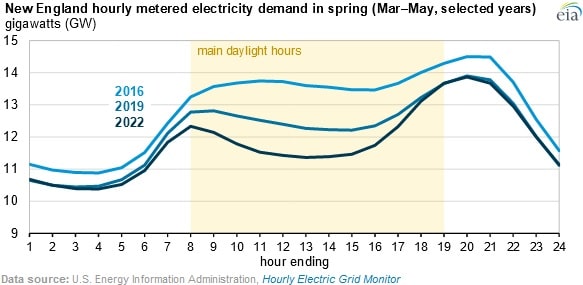Customer-Sited Solar is Changing New England Electricity Demand Pattern: EIA

The growth in power generation from small-scale, customer-sited solar installations is altering the hourly pattern of metered electricity demand in New England during spring – March to May, according to the U.S. Energy Information Administration. Since 2016, New England has added 3.8 gigawatts to its grid, with small-scale solar accounting for 60 percent of that total.
Small-scale photovoltaic systems have a capacity of less than 1 megawatt and typically produce more in the morning and less in the evening. As a result of this type of generating capacity, utilities’ energy demand changes over different hours of the day. Significantly, the demand reached its lowest in the morning and peaked in the evening during the spring.
Key factors influencing solar energy in New England:
According to the New England grid operator’s 2022 PV forecast, the major drivers influencing the potential of solar energy in New England are:
- Feed-in-tariffs (FITs)
- Long-term procurement
- State renewable portfolio standards (RPS)
- Net energy metering (NEM)
- Federal Investment Tax Credit (ITC)
Other factors affecting the commercialization of solar PV are private equity investment in solar development, PV business model, future equipment and installation costs, andfuture wholesale and retail electricity costs.
Generally, small-scale generators are not metered by utilities, and they are expected to share in reduced electricity demand. It is noted that the EIA’s Hourly Electric Grid Monitor tracks utility-scale solar systems having a capacity of at least 1 megawatt. Small-scale generations are not considered a source of power generation.
Ambitious climate commitments have prompted New England states to enact rules and regulations that are designed to reduce carbon emissions in the upcoming decades. Renewables in New England energy resources are expected to contribute 56 percent of electricity in 2040, up from 12 percent in 2021. Five of the six New England states have committed to reduce emissions by at least 80 percent over the next 20-30 years compared to 1990 levels. Independent states within the region have set their own goals to reduce carbon emissions, and the policies developed by the states are aligned with the way they use energy resources. For example, in the last three decades, states within the region have largely relied on natural gas to replace high carbon emission sources like crude oil and coal. In the upcoming decades, these states are expected to adopt renewable energy sources like solar and wind, replacing natural gas.
New England has seen many “duck curve” days showing the change in electricity demand and the available solar energy – a deep midday drop in net load caused by ample solar generation, and a steep ramp-up into the evening when the sun sets. These trends are likely to accelerate in the upcoming years since the behind-the-meter solar systems are expected to grow in the New England region.
EnerKnol Pulses like this one are powered by the EnerKnol Platform—the first comprehensive database for real-time energy policy tracking. Sign up for a free trial below for access to key regulatory data and deep industry insights across the energy spectrum.
ACCESS FREE TRIAL